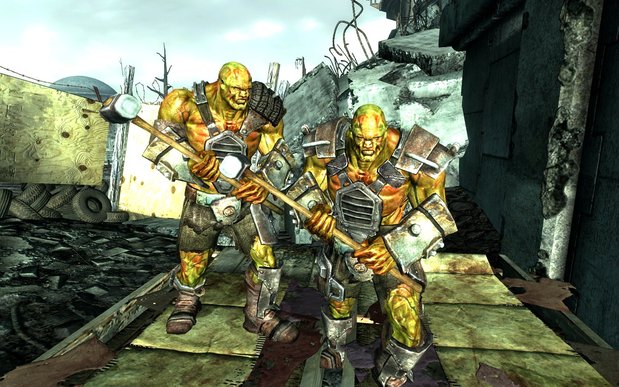The Science of Fallout, part 2
We’re back with the second part of our quest to find good science in the New California Republic
A couple weeks ago, we took our first steps into the charred remains of North America to try to investigate how much – if any – of Fallout’s world we can look forward to (or dread) in the future. In fact, it was really more dread than hope. Portable nukes and radiation sickness aren’t really anything to get excited about. This edition offers a slightly more mixed bag of goodness and horror. And in the case of the Forced Evolutionary Virus...a little of both.

Above: Don't worry, there won't be a super mutant on the end of this chain by 2077
Forced Evolutionary Virus
Even if somebody managed to survive all of the perils of radiation we talked about in the last Science of Games, the Fallout world is still filled to the brim with outstandingly stupid people creating outstandingly stupid things that will kill you. The Forced Evolutionary Virus is one of those wonderfully dumb creations.
Those super mutants you see wandering the Capital Wasteland aren’t genetic mutations resulting from years of radiation. The worst that stuff will give you is a kid with an extra, goofy-looking arm. The super mutants were created by a corporation called West Tek, which was seeking a way to combat the threat of a Chinese biological super-virus. West Tek devised a way to alter the structure of DNA from a double-helix structure into a quadruple-helix structure. Though it was designed from the beginning as a way to boost immunity, they soon saw mutations in their animal test subjects.

Above: At least, we don't think there'll be a super mutant on the end of that chain by 2077
The increased brain power and muscle mass got the government bigwigs thinking, and gave them starry eyes about the idea of soldiers so intelligent and strong that they could outwit and overrun a Chinese adversary that had much larger numbers on its side. That’s the gist of the origin story. There’s quite a bit more lore that goes along with how super mutants came to be roaming the landscape, which you can look into further on your own.
The short answer is that quadruple-helix DNA doesn’t exist, and probably won’t. They’re not inherently impossible, but all known forms of life have a double-helix, and it works pretty well for the most part. There’s no reason to suspect extra genetic information would make you extra-powerful. In fact, it can often lead to issues like Down’s Syndrome.
Weekly digests, tales from the communities you love, and more
However, there is hope for the quadruple-helix, or a “DNA tetraplex.” The structure can be used in nanomachines to move and propel the little bot with great precision. One suggested potential use for this is the blocking of specific chromosomes, such as genes that cause cancer. Military applications are as-yet unknown.
Dirty Bombs
Last week we went into the nasty ramifications of an irradiated landscape, but how did it become that way in the first place? It’s common knowledge that nuclear bombs give off intense radiation, but not all nukes are created the same.
The nuclear atrocities of the Fallout world were achieved by dirty neutron bombs, which sacrifice explosive power in favor of a massive dose of radiation spewed out in all directions. That’s the major reason why radiation is still so prevalent in their world.

Above: Regardless of what type of nuke it is, if you see this, you're probably screwed
In our own world, nuclear bombs have come a long way since the Fat Man and Little Boy of the 1940s. Explosive yield has skyrocketed from kilotons into the megatons, but we’ve also gotten a better handle on the long-term ramifications of radiation, as well. The most powerful nukes we currently have today are not the fission-based nukes of old, but rather fusion-based.
It’s a different type of reaction which doesn’t produce as much nasty neutron radiation in relation to the destructive power. These thermonuclear weapons are detonated in stages, with an old-school fission bomb placed inside a special radiation-reflecting container filled with fusion fuel (usually deuterium or tritium, fancy Hydrogen with more neutrons.) The old school bomb pops off and superheats the fusion material, to create a fusion reaction. Then the fusion reaction can be used to heat the original material (uranium) used in the first, old-school reaction, to create another reaction.
Because of the way these stages stack on top of each other, you can essentially create a bomb as big as you please. Which is how we ended up with the Tsar Bomba (which Ravenbom and Warren-Miller were kind enough to correct me on last time), which was originally designed at 100 MEGAtons, not kilotons. The ongoing escalation of nuclear yield stopped at 100 megatons because Russians scientists were actually concerned it might crack the Earth’s crust.
In short, we have better, cleaner options for wiping out entire cultures nowadays. You’d have to be a sick dude to intentionally use a dirty bomb to irradiate the landscape and ensure as many people die a horrible death as possible.
Holographic Storage
On to sunnier topics! Now that we’ve got you nice and depressed and thinking about your inevitable nuclear destruction, we’ll move on to something a tad more relevant to gamers, the most interesting topic man has ever discussed: hard drives.
Holodisks are a consistent component of the Fallout world, and are seen as a futuristic way of storing large amounts of data. It’s even hinted that the government may have had access to holodisks that could store up to 4 terabytes of data. Why is it that nobody can ever come up with a decent futuristic data-storage capacity? Four-terabyte hard drives are already on store shelves; we’ll probably have that much capacity from flash drives by 2013.

The larger issue is that holographic storage is actually a burgeoning field of research, and many believe it will one day unlock the key to incredibly huge amounts of storage capacity.
Conventional methods of data storage today involve optical surfaces or magnetic material. The problem with this is that data can usually only be stored on a two-dimensional surface. Holographic storage allows you to store date in all three dimensions, exponentially increasing the available storage space.
Furthermore, these holographic devices could theoretically read millions of bits of information all at once, rather than relying on the slow trickle of information that we use today.


